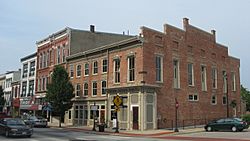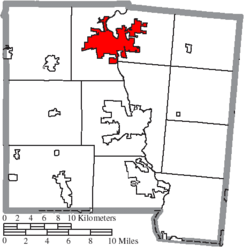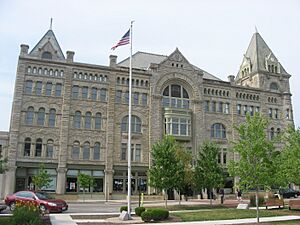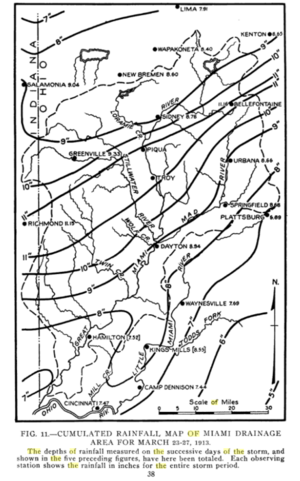Piqua, Ohio facts for kids
Quick facts for kids
Piqua, Ohio
|
|
|---|---|

Downtown Piqua
|
|

Location of Piqua in Miami County
|
|
| Country | United States |
| State | Ohio |
| County | Miami |
| Area | |
| • Total | 12.04 sq mi (31.18 km2) |
| • Land | 11.77 sq mi (30.50 km2) |
| • Water | 0.26 sq mi (0.68 km2) |
| Elevation | 873 ft (266 m) |
| Population
(2020)
|
|
| • Total | 20,354 |
| • Density | 1,728.72/sq mi (667.45/km2) |
| Time zone | UTC-5 (Eastern (EST)) |
| • Summer (DST) | UTC-4 (EDT) |
| ZIP code |
45356
|
| Area code(s) | 937, 326 |
| FIPS code | 39-62848 |
| GNIS feature ID | 2396215 |
| Website | http://www.piquaoh.org/ |
Piqua (pronounced PIK-wuh) is a city in Miami County, Ohio, United States. It is located along the Great Miami River. In 2020, about 20,354 people lived there. Piqua is about 27 miles north of Dayton and is part of the larger Dayton metropolitan area.
Contents
History of Piqua
What does the name Piqua mean?
The name 'Piqua' comes from a Shawnee language phrase. It means "He has risen from the ashes." This name is linked to an old legend of the Shawnee people. It also became connected to the Pekowi, one of the five main groups of the Shawnee people.
Early Settlements and Battles
In 1749, the British built Fort Pickawillany. This fort was made to protect their trading post near a Miami village. It was located where Loramie Creek meets the Great Miami River.
In 1752, a war chief named Charles Michel de Langlade attacked the fort. He led over 240 Odawa and Ojibwe warriors who were allied with French forces. This event was called the Battle of Pickawillany. During the battle, the Miami chief and a British trader were killed.
After this battle, the British and Miami people left the site. The Miami later rebuilt their village nearby. Piqua then grew close to this new village. The British took control of the area after winning the French and Indian War.
Until 1780, the main town of the Shawnee was also called Piqua. It was located on the Mad River, about 23 miles southeast of the modern city. In 1780, General George Rogers Clark led an expedition that ended in the Battle of Piqua. After this battle, the Shawnee town and its fields were burned.
The Shawnee then moved north and west to the Great Miami River. They settled two new villages in late 1780, known as Upper Piqua and Lower Piqua. By 1790, these sites were found abandoned.
In 1794, General Anthony Wayne suggested building forts along the Miami River. A small fort and supply base called Fort Piqua was built in Upper Piqua during the winter of 1794–95. It was abandoned after the Treaty of Greenville was signed in 1795. This treaty opened up much of Ohio for new settlers.
Modern Piqua Begins
The first European settlers arrived in 1798. In 1807, a village with seven houses was surveyed and named Washington. This village was about a mile southwest of the old Shawnee villages.
By 1816, the Shawnee village of Piqua had been empty for a long time. The state government changed the name of Washington village to Piqua. Piqua officially became a town in 1823.
During the War of 1812, Piqua was an important stop for soldiers and supplies. The city grew even more with the building of the Miami and Erie Canal between 1825 and 1845.
Rossville: A Community for Freed People
Rossville, Ohio was the first community in the area for free Black people. In 1833, a Virginia plantation owner named John Randolph of Roanoke arranged for his nearly 400 enslaved people to be freed in his will. He also provided money to help them move to Ohio, a free state.
In 1846, his 383 enslaved people gained their freedom. Most of them settled in Rumley, Ohio. Some later founded Rossville and a cemetery called the African Jackson Cemetery. These are located on the northeast side of the Great Miami River. Rossville has since become part of Piqua.
The Great Flood of 1913

Piqua is located in a curvy part of the Great Miami River. Because of this, it often experienced floods. One of the worst floods happened in 1913.
On March 22, 1913, a storm brought a lot of rain. The heaviest rain fell between March 23 and March 27. Some areas between Piqua and Troy received up to 11 inches of rain.
The floodwaters came very quickly and powerfully. Homes were moved off their foundations, and many were filled with mud. Forty-nine people died in Piqua and nearby Rossville. Streets were damaged, and public services like gas and water were disrupted.
The flood caused about $1,000,000 in damage in Piqua. The Ohio and Erie Canal, which had been important for trade, was so badly damaged that it closed permanently.
Piqua: The Atomic City
Piqua was once home to the first nuclear power plant run by a city. This was the Piqua Nuclear Generating Station. It operated from 1963 to 1966 as a test project. The plant was closed early due to technical problems and other reasons.
Geography and Location
Piqua covers a total area of about 11.89 square miles. Most of this area is land, with a small part being water. The Great Miami River flows through the city. The southern part of Piqua, on the east side of the river, is known as Shawnee.
Population and People
| Historical population | |||
|---|---|---|---|
| Census | Pop. | %± | |
| 1810 | 287 | — | |
| 1820 | 350 | 22.0% | |
| 1830 | 488 | 39.4% | |
| 1840 | 1,480 | 203.3% | |
| 1850 | 3,277 | 121.4% | |
| 1860 | 4,616 | 40.9% | |
| 1870 | 5,967 | 29.3% | |
| 1880 | 6,031 | 1.1% | |
| 1890 | 9,090 | 50.7% | |
| 1900 | 12,172 | 33.9% | |
| 1910 | 13,388 | 10.0% | |
| 1920 | 15,044 | 12.4% | |
| 1930 | 16,009 | 6.4% | |
| 1940 | 16,049 | 0.2% | |
| 1950 | 17,447 | 8.7% | |
| 1960 | 19,219 | 10.2% | |
| 1970 | 20,741 | 7.9% | |
| 1980 | 20,480 | −1.3% | |
| 1990 | 20,612 | 0.6% | |
| 2000 | 20,738 | 0.6% | |
| 2010 | 20,522 | −1.0% | |
| 2020 | 20,354 | −0.8% | |
| 2021 (est.) | 20,442 | −0.4% | |
| Sources: | |||
Piqua's Population in 2010
In 2010, Piqua had 20,522 people living in 8,318 households. The city had about 1,766 people per square mile. Most residents (92.4%) were White. About 3.3% were African American, and 1.4% were Hispanic or Latino.
About 24.8% of the residents were under 18 years old. The average age in the city was 38.1 years.
Economy and Businesses
Piqua is home to Hartzell Propeller, which makes propellers for small airplanes. Evenflo is another major employer. It makes car seats and other products for babies and toddlers.
The French Oil Mill Machinery Company
In the late 1800s, Piqua was a center for processing flaxseed. Flaxseed was "crushed" to get linseed oil, which was used for many industrial products like linoleum flooring.
In 1900, a company called The French Oil Mill Machinery Company was founded in Piqua. It was started by Alfred Willard French, an engineer who invented new machines for oil mills. The company quickly became known for its strong and effective machinery.
Today, this company sells its equipment to over 80 countries. It still helps extract oil from seeds like soybeans and canola. The company also makes machines for processing rubber and hydraulic presses for different materials.
Past Industries
For many years, Piqua was a major center for making underwear. There was even an Outdoor Underwear Festival held downtown from 1988 until the main factory closed.
Other companies in Piqua's past include:
- The Meteor Motor Car Company, which made ambulances and hearses.
- The Piqua Coca-Cola Bottling Company, which produced soft drinks for the area.
- The Val Decker Packing Company, which made hams, hot dogs, and other meats.
Piqua's industrial history brought a lot of wealth to the city. This can be seen in the large mansions and homes near downtown, like the Leo Flesh Mansion.
Shopping and Retail
Piqua has a shopping mall called Miami Valley Centre Mall, which opened in 1988. There is also Miami Valley Crossing, a plaza with several large stores.
Top Employers in Piqua
Here are some of the biggest employers in Piqua:
| # | Employer | # of Employees |
|---|---|---|
| 1 | Evenflo | 606 |
| 2 | Industry Products Company | 411 |
| 3 | Nitto Denko Automotive Ohio | 354 |
| 4 | Walmart | 337 |
| 5 | Piqua City Schools | 320 |
| 6 | Hartzell Propeller | 313 |
| 7 | Piqua Steel Company | 304 |
| 8 | Crane Pumps & Systems Inc | 298 |
| 9 | United Parcel Services | 287 |
| 10 | City of Piqua | 231 |
Arts and Culture

The Fort Piqua Plaza building was built in 1891. For many years, it was a hotel known by different names, including "Fort Piqua." The hotel closed in the 1980s.
Over the years, the building's street-level shops housed many businesses. These included a barbershop, a bank, and a popular soda fountain.
After a period of neglect, the building was fully renovated. Since 2008, it has been home to the city's public library. It also has a restaurant and bar. The building is now known as Fort Piqua Plaza.
Piqua was once famous for its underwear manufacturing. From 1886, there were 14 companies making underwear in the city. This industry lasted until 1993.
The Underwear Festival was started in 1988 to celebrate this history. It was a two-day event with entertainment. Organizers said it was a family-friendly event. The festival ended in 1998 because there weren't enough volunteers.
Education in Piqua
The Piqua City School District serves the entire city. It includes two elementary schools, an intermediate school, a middle school, a junior high school, and Piqua High School.
Piqua is also home to the Upper Valley Career Center. There are also private schools like Piqua Catholic School and the Nicholas School.
Edison State Community College is located in Piqua. It was established in 1973 as Ohio's first general and technical college.
Media
The Piqua Daily Call newspaper was published daily from 1884 to 2019. It then combined with the Troy Daily News to form Miami Valley Today. This new paper is published Tuesday through Friday.
Piqua also has local radio stations: WPTW 1570 AM and 98.1 FM. There is also WPLC 95.1 low-power FM, which repeats the Three Angels Broadcasting Network.
Transportation
Piqua has two main streets. One runs north and south along Miami County Road 25-A, which was once U.S. Route 25. The other runs east through Shawnee. U.S. Route 36 also goes through the city, almost cutting it in half.
A former railroad line that ran through downtown Piqua was turned into a bike trail in 2001. It is now called Linear Park. Another rail line, operated by CSX Transportation (CSXT), still serves Piqua.
Notable people from Piqua
- Kenneth W. Benner - brigadier general, USMC and veteran of World War II
- Brock Bolen - football player
- Craig Clemons - football player
- John W. Daniels - co-founder and former CEO of Archer-Daniels-Midland (ADM)
- Matt Finkes - New York Jets defensive end
- Dominic Salvatore Gentile - World War II ace pilot
- Terri Hemmert - Chicago disc jockey
- Charles Blue Jacket - 19th-Century Shawnee chief and Methodist minister
- James Kaiser - electrical engineer who developed the Kaiser window for digital signal processing
- Girard Edward Kalbfleisch - U.S. federal judge
- Kristin King - player on the bronze medal-winning women's U.S. Hockey team at the 2006 Winter Olympics
- Ollie Klee - baseball player
- Bill Lear - inventor and businessman, founder of Lear Jet and inventor of the 8-track cartridge
- William McCulloch - lawyer, U.S. Representative, and an author of the Civil Rights Act of 1964
- John F. McKinney - U.S. Representative from Ohio
- Rich McKinney - baseball player
- Mills Brothers - jazz musicians, inducted into the Vocal Group Hall of Fame
- John G. Mitchell - general in the Union Army
- J. T. Patterson - geneticist
- Quinn Pitcock - football player
- William H. Pitsenbarger - Air Force pararescueman posthumously awarded the Medal of Honor
- Louis Joseph Reicher - first Bishop of Austin, Texas
- Harry Reser - banjo player and bandleader
- Stephen Clegg Rowan - vice admiral, U.S. Navy
- Brandon Saine - football player
- Helen Schelle - founding partner of Fisher-Price, toy manufacturer
- Lawrence Yates Sherman - U.S. Senator and Lieutenant Governor of Illinois
- Tanya Thornton Shewell - member of the Maryland House of Delegates
- Hiram Y. Smith - lawyer and U.S. Representative from Iowa
- Mike Smith - baseball player
- Jack Snow - fantasy and horror author
- Muffin Spencer-Devlin - professional golfer
- Joseph J. Spengler - economist, statistician, and historian of economic thought
- Aileen Cole Stewart (1893-1997), African American United States Army Nurse Corps nurse during World War I.
- Lester J. Whitlock, U.S. Army major general
- Joseph Widney - doctor, educator, historian, and religious leader
- Robert M. Widney - founding father of the University of Southern California
- James P. Wisecup - vice admiral, U.S. Navy
- Patrick Zircher - artist, Marvel and DC comics
See also
 In Spanish: Piqua (Ohio) para niños
In Spanish: Piqua (Ohio) para niños





